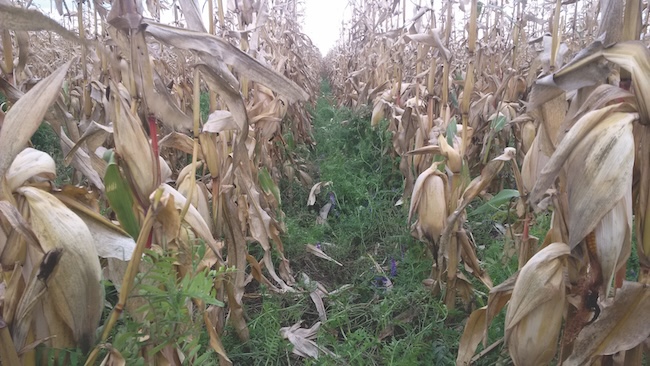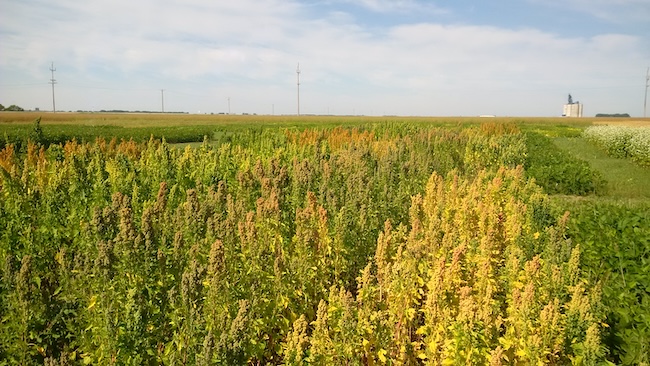
Features
Biodiversity
Other Crops
Crop diversification growing pains
What worked, what hasn’t and where are the opportunities.
February 6, 2025
By Bruce Barker
 Corn interseeded with hairy vetch was a profitable grazing crop.
All photos courtesy of Scott Chalmers.
Corn interseeded with hairy vetch was a profitable grazing crop.
All photos courtesy of Scott Chalmers.
Variety is the spice of life, and so is crop diversity. But while crop diversity brings many benefits, it is easier said than done.
“We have grown 145 different crops at Manitoba’s Diversification Centres over the years in an attempt to help diversify the number of crops grown in Manitoba,” says Scott Chalmers with the Westman Agricultural Diversification Organization (WADO) at Melita, Man. “Not all were winners and not all were losers.”
There are four Manitoba Diversification Centres that include the Manitoba Crop Diversification Centre (MCDC) at Carberry, the Parkland Crop Diversification Foundation at Roblin, the Prairies East Sustainable Agriculture Initiative at Arborg, and WADO. Their locations cover a wide range of soils and growing conditions. They are non-profit organizations that conduct applied research and demonstrations on crops, technology and best management practices.
One of the reasons Chalmers feels that research into crop diversity is so important are the projections in climate change. By 2050, the Climate Atlas predicts that southwest Manitoba will have an increase of almost 450 CHU but precipitation will not increase. “I feel we are heading into something we aren’t too sure about.”
In Manitoba in 2022, 11 crops are grown on 97 per cent of the 11,241,000 acres of cropland. This is dominated by spring wheat (27 per cent of acres) and canola (29 per cent). The remaining three per cent have over 100 crops grown on the 345,851 acres. These range from potato, flax and sunflower to hemp and proso millet.
Chalmers says crop diversification is important to help reduce environmental and economic risk, improve domestic self-sufficiency in food, provide a diversity in human and animal diets, and to improve economic development and gross domestic product.
Corn and soybean are success stories in Manitoba. Soybean went from basically no production in 2000 to over 2.2 million acres in 2017 before dropping back to 1.6 million acres in 2023. The large growth was due to the introduction of glyphosate-tolerant soybeans, and wet years during the mid-2010s when soybeans thrived. Corn has also seen a steady increase over the past 35 years in terms of both acreage (around 350,000 acres) and also yield (156 bu/ac 2022 yield).
Chalmers cites a corn and hairy vetch intercrop at Pierson, Man. as another one of the success stories he has seen. The two crops were sown in one pass with a SeedMaster UltraPro seed distribution system that allowed the hair vetch to be sown between the rows of corn. The mature crop was grazed by bison and the rancher calculated a feed savings of $0.40 per pound gain per cow per day.
Industrial hemp is another success story. Grain yield is between 1,000 and 1,500 lb./ac. and fibre yields vary from 3,000 to 15,000 lb./ac. The grain is used for oil and protein. The fibre has multiple uses from insulation to bedding, clothing and composites.
Field pea production has also expanded in Manitoba from what was once a niche crop. Average yield in Manitoba in 2022 was 54 bu./ac. At Portage la Prairie, Man., Roquette has opened the world’s largest pea protein plant creating a new market for pea growers. Pea production, though, is being challenged by root rots that require a long rotation of up to eight years between pea crops, and controlling herbicide resistant weeds is also becoming an issue.
Quinoa is another crop that is showing potential in Manitoba. There is a local market for production at Prairie Quinoa at Portage la Prairie. The crop has yielded 1,000 to 1,800 lb./ac. and its niche is as a gluten-free alternative. Chalmers says it is very drought tolerant. Production challenges include few weed control options, and susceptibility to several insects including Lygus bug and bertha armyworm.
Potato production in Manitoba has also been a success. Yield in 2022 was 330 cwt/ac and the production is used for both table and processing markets. Farmers have the assurance of price through the Keystone Potato Producers Association who negotiates farmgate prices. The crop has the support of MCDC research and local demand is high for the production. Concerns include verticillium wilt disease and Colorado potato beetles.
“What I think is cool is cover crop research with mustard as a biofumigant before potato. Mustard is grown up to flowering, and then plowed under. Isothiocyanates, the compound that gives mustard its spiciness, converts to cyanide which acts as a biofumigant,” says Chalmers. Mustard biofumigant has been shown to control a variety of soilborne pests, including verticillium, fusarium, rhizoctonia, sclerotinia, pythium, common scab, nematodes and wireworms.
Failures
Chalmers says it’s important to look at not only success stories, but also the failures.With a yield of zero bu./ac. in Manitoba, rice diversification was a complete failure. Seed was planted in late May and the rice took two weeks to emerge. “The crop came up way too late for any kind of production,” says Chalmers. “It’s just too cold.”
Guar beans was another complete failure with the crop not reaching maturity or seed set. Guar beans are used in food production, but the interest in Manitoba was for its use in oil field fracking to increase oil well productivity. It’s normally grown in Texas, Africa and India, but the Manitoba climate was found to be too cold.
Niger seed showed potential, but low yields of 200 to 700 lb./ac. meant it couldn’t compete with other commodities. It is used as bird seed, and in Chapati bread. It proved to be drought tolerant, but it has no registered herbicides and was difficult to get sieve settings on a combine set properly.
Calendula was also a flop. It had a low yield of 500 lb./ac. and oil extraction was difficult. Chalmers conducted research on it because a Netherlands company wanted to move to Manitoba because the land was so cheap compared to in the Netherlands. Calendula is used as a hardener in lacquer paint and was supposed to help replace tung oil. The company didn’t relocate, and the potential was never realized.
Opportunities
From his research, Chalmers sees some opportunities in other crops. Camelina, specifically fall-seed camelina, has potential as a very competitive, saline and drought-tolerant, early maturing crop. It is used in food oils, fish meal and animal care. It is susceptible to powdery mildew and fusarium wilt, and few herbicides are registered.
Flax grown for fibre is another opportunity. Biomass yields range from 3,800 to 4,550 lb./ac. with a 30 per cent fibre yield. The challenge is the lack of a North American processor/market. “We can compete with cotton yields. We can do this with the right infrastructure.”
Hops, as most beer drinkers know, are grown for flavoring beer. “I think hops could be an opportunity. It yields 1,000 lb./ac. and pays $20 per pound to gross $20,000/ac. It is very labour intensive, and bugs love it, but it could be very profitable,” says Chalmers.
Another gluten-free alternative, Chalmers says teff has high grain yield of 1,500 to 2,500 lb./ac. or 8,000 to 10,000 lb./ac. as a hay crop. It’s drought tolerant, provides two cuts of hay, and has potential for an intercrop with oats.
Lupins also show potential as a high-protein crop. While it yields lower than pea, its 36 per cent protein content makes up for the lower yield. Pea, by comparison, has 24 per cent protein. A major benefit is that lupins are Aphanomyces resistant, meaning it can be grown more frequently in rotation than pea’s crop rotational break.
Buckwheat as a nutraceutical is another opportunity. Forty-four per cent of the biomass production is leaves and flowers which contains rutin. Rutin is an antioxidant with anti-inflammatory properties. Holding production back is the lack of large-scale extraction plants, and a way to dry down the crop after cutting.
“It’s not easy establishing a new crop,” says Chalmers. “Big acre crops are stable industries and pay the bills more dependably, but fringe crops are more risky because they generally have greater challenges.”
